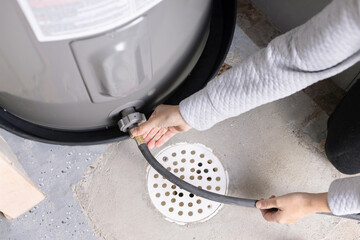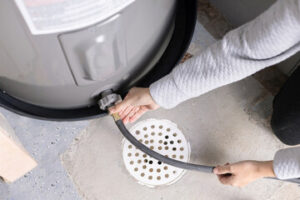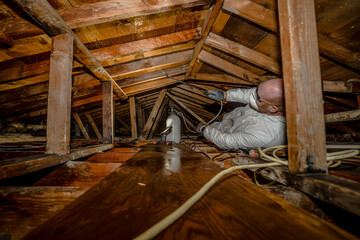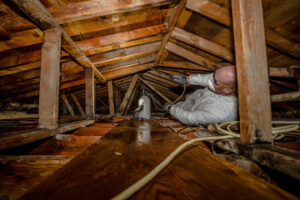A covering for a building’s top, protecting from rain, snow, sunlight, and extremes of temperature. Roofs come in a variety of forms and constructions.
Choosing the right roofing materials is one of the biggest decisions you’ll make when reroofing your house. There are several options, from basic asphalt shingles to luxurious slate. Contact North Port FL Roofing for professional help.
The materials used in roofing can add to the style and beauty of a home as well as provide protection from the elements. The most common type of roofing is asphalt shingles, which are available in different colors and styles to complement a range of home types and climates. Other types of roofs include wood, clay tile, and metal.
Wood shingles and shakes pair beautifully with classic and historic-style homes and are available in a variety of color choices. Cedar and redwood are the most popular types of wood shingles, but they’re also available in a variety of other species. Shingles are thin wedge-shaped slabs that are produced by precise sawing, while shakes are thicker wedges with a more rugged texture. Both options offer a natural look that enhances the style of a home, but they are more expensive than other roofing materials and don’t do as well in damp climates.
Metal roofing is a durable option that can last for decades. It comes in a variety of colors, designs, and price points to match a range of home styles. It’s a good choice for high-wind regions and can withstand strong storms, salty air, and even wildfires. Metal is lightweight, but it’s also a heavy material that requires special framing and installation.
Slate is a beautiful and traditional roofing material that’s often found on luxury homes. It’s one of the most long-lasting roofs, with some examples dating back hundreds of years. Unfortunately, slate is also quite expensive and difficult to install, which can drive up the cost of a new roof.
Another durable roofing option is built-up roofing, or BUR. It’s an ideal choice for flat or low-pitch roofs. This type of roofing uses multiple layers to form the roof. The outer layer is typically a felt or tar paper that’s reinforced with either organic or fiberglass mats. The middle layer is a coal tar or asphalt, and the lower layer is usually gravel or crushed rock. Built-up roofing can withstand severe weather conditions but may require maintenance. It’s a good choice for a garage or shed, but it isn’t recommended for use over living spaces.
Installation
A roof is the top covering of a building, serving to protect against rain, snow, sunlight, wind, and extremes of temperature. It may be flat, pitched, vaulted, domed, or any other form dictated by design or structural considerations. Roofing materials are typically made from wood, metal, or plastic (PVC), and can be assembled in a variety of ways to achieve functional and aesthetic goals.
Before a contractor begins the installation process, they will set up their work area by covering anything nearby that isn’t part of your home, like vehicles and plants with tarps or wooden boards. This will keep roofing debris from falling and damaging your property. Once they’ve established their work area, they will begin to prepare the roof. They will remove any existing shingles and clean the surface to ensure that the new materials adhere properly.
Then they will install the underlayment, starting at one end of the roof and working towards the other end. This will be done in rows, with each row being overlapped by the previous by at least six inches. Nails will be placed close to the edge of each row and then spread out further towards the middle. Waterproofing will also be installed in the valleys, which are where the slopes of the roof meet and form a “V” shape. The valleys are prone to leaks, so the waterproofing will help prevent them.
Maintenance
Performing routine maintenance procedures extends the life of roofing and reduces its total cost of ownership. During maintenance, the facility staff will inspect for small areas of deterioration and promptly repair them to prevent leaks, mildew and other problems. These efforts save on energy costs, avoid expensive repairs and protect interior valuables.
The roof is an integral part of any building and provides aesthetic value, all-round protection and many other functional benefits. The roof also adds considerable resale value to your home. However, most homeowners tend to neglect their roofs until they face serious problems. The most common problems include deteriorating shingles, loose or missing roof tiles, poor air flow through the attic and ceilings, water leakage and discolored interior walls.
A roofing system should be inspected on an annual basis. It should be walked and examined for any signs of damage or deterioration, such as fading shingles, excessive wear and tear from hail, high wind, clogged drains, and faulty flashings. The flashing around chimneys and vent pipes should be inspected for cracking, openings and deterioration on an annual basis as well.
Another important maintenance procedure involves trimming tree branches, especially those that hang over the roof. In heavy storms, tumbling branches can damage or even puncture the roof surface. In addition, they can obstruct rain gutters and clog the drainage system. It is also a good idea to regularly inspect and clean the gutters.
Facility staff should also inspect stairs, crossovers and platforms for structural soundness and safety. Any unsafe conditions should be addressed immediately, to avoid injuries to personnel who may have to go up to the roof for inspection or maintenance work. This is particularly important if there are electrical or dangerous chemicals present on the rooftop.
It is recommended to conduct a thorough inspection before the start of each season. This will help to identify any problems that could exacerbate during the season, such as heat damage, hurricane damage, or snow and ice damage. Additionally, a detailed logbook or digital file should be maintained to record the dates of all inspections and maintenance tasks that are conducted. This will be helpful in case of warranty claims or when the house is sold in the future.
Repairs
It’s important to regularly inspect your roof to identify leaks and damage. This prevents these issues from escalating into larger and more expensive problems. Regular maintenance and timely repairs can help extend the lifespan of your roof, saving you money on energy costs and avoiding major structural damage to your home.
Whether your roof needs to be repaired or replaced, a qualified roofing professional will be able to identify and address any areas of concern. Using the proper materials and techniques, they can repair cracks, missing shingles or deteriorating sealants to help keep your home protected. In addition, roofing professionals can recommend and install insulation to help reduce your home’s energy consumption, making it more sustainable and reducing your environmental footprint.
The cost of repairing your roof depends on the type of material and extent of damage. Asphalt shingles are typically on the lower end of the price range, while metal and slate tiles are on the higher end. The pitch or design of your roof also has a significant impact on the cost. A steep or complicated roof will require more labor and materials, which drives up the overall cost of the project.
Before you make any repairs, be sure to take a look at the interior of your home – in your attic, crawl space or whatever other area you have access to that’s closest to the roof. Any stains, signs of water damage or damp spots on the ceiling should be a red flag and warrant immediate attention. If any of this is occurring, a quick call to a local roofer should be made.






 Pest infestations can be a nuisance, posing health risks and damaging property. While various methods exist to control pests, traps remain one of the most effective and environmentally friendly solutions. This guide will delve into
Pest infestations can be a nuisance, posing health risks and damaging property. While various methods exist to control pests, traps remain one of the most effective and environmentally friendly solutions. This guide will delve into 
 Only an experienced professional at
Only an experienced professional at 
